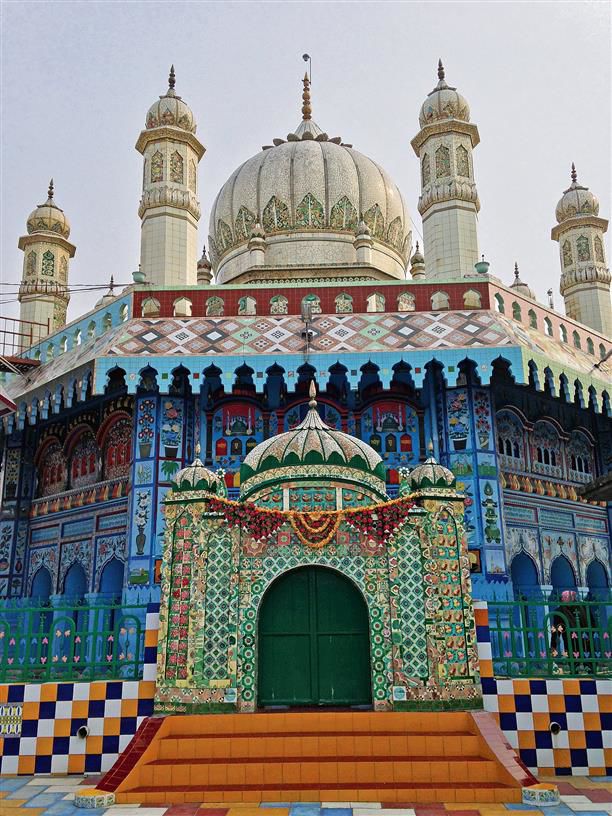Roza Sharif Mandhali: Doaba shrine’s worldview
Yogesh Snehi
Partition violence during the intervening months of July to September 1947 led to an exodus of the Muslim population of east Punjab to west Punjab. The tragedy that unfolded on either side has been retold by a generation of writers and scholars. The Partition migration also led to the desolation of a large spectrum of mosques, madrasas, graveyards and Sufi saint shrines in east Punjab, as the incumbent gaddi-nashin (caretakers) too migrated. A few places braved the madness of violence, like the princely state of Malerkotla.
At the shrine of Roza Sharif Mandhali in Doaba, the family of then gaddi-nashin Bibi Rehmat was partitioned. Her youngest son, Rana Ali Ahmed, stayed back with his father, who soon died in 1950. Rana Ali Ahmed was born in 1900 and, after 1947, became the third successor of Roza Sharif. He is remembered as Sabir Data Ali Ahmed Shah Qadiri (died 1985) and emerged as one of the most revered saint figures in the surrounding areas of Banga, Phagwara and Behram. The shrine is particularly popular among the Dalits of the Doaba region.
Several shrines in Punjab came up on existing sacred places (jatheras of ancestors). Roza Sharif Mandhali, established along the jathera of Jat ‘got’ Badeshaa, has a network of four sister shrines. The parent shrine, constructed by Baba Abdullah Shah (died 1908), is at Mandhali and Sai Umre Shah Qadiri is its current gaddi-nashin. Two shrines have female gaddi-nashins. Both aesthetically and culturally, Roza Sharif Mandhali stands out for its wall murals, use of encaustic tiles, besides invocation of feminine sensibilities and Nath inheritance of its saint figures.
The central structure can be traced back to the 19th century; some of its original wall paintings were extant when I visited it a few years back. The walls invoke the shrine’s Islamic and Sufi lineage by inscribing verses from the Koran, Sufi compositions in Punjabi, and names of Prophet Muhammad, Hazrat Ali, Imam Hasan and Husain, Bibi Fatima. These saints are placed along Qadiri saints associated with Roza Sharif Mandhali and nearby shrines: Baba Fatteh Shah, Sai Kale Shah and Chaudhary Natthu Shah, among others. It is interesting to note the reference to the quintessential Machhendranath, founder of ‘Nath Sampradaya’.
The walls of the shrine are richly decorated in indigenous and European styles. These include local and exotic varieties of flowers and petals, elephants, pegasuses (winged horses), winged fairies (apsaras), snow-clad mountains, African and Asiatic lions, dolphins, scenes from rural Punjab, Gaddi women, and Persian wheel. Mecca and Medina figure prominently, as do Ajmer Sharif and Kaliyar Sharif of Sabir Pak.
Murals also depict stories associated with Sufi saints and their iconography such as Shaikh Abdul Qadir Jilani, Baba Farid, Khwaja Khizr and Baba Lakhdata. Floral subjects figure in mosaic and encaustic tiles that date back to the 19th century. Human and animal subjects appear more prominently in contemporary tiles.
The most fascinating aspect of the murals is the representation of contemporary saints. The templates have been copied from photographic images. These appear as standalone visuals or as assemblages of saints. The background is usually reworked to place the saints in the Islamic cosmology, or in musical gatherings (qawwalis), and/or nature settings. The saints appear to be connected to divine grace which flows on them from the cosmos. The more recent saints appear strikingly feminine as they wear nose rings and earrings and apply henna. Popular Punjabi singers like Gurdas Mann and Lakhwinder Wadali have been associated with this shrine and trace their musical lineage to a network of Qadiri shrines in the Doaba and Majha regions. The shrine’s architecture blends Nath, Islamicate and gurdwara forms. The central tomb is a two-storey dargah of Abdullah Shah. Set in an octagonal plan on a raised square platform, this shrine is surrounded and replicated on all four corners by smaller burial and/or memorial shrines dedicated to Data Ali Ahmed Shah, Baba Bhure Shah and Sai Umre Shah, Baba Bhajan Shah and Sai Bille Shah, and Baba Machhendranath, Sai Kalu Shah, Baba Chidi Shah, Chaudhary Nathu Shah and Baba Nathu Shah.
There is a tall flagpost adjacent to the small gateway to the shrines that attests to its sovereignty in the landscape of Jalandhar Doab, and small niches to light oil lamps. The adjacent three-bay mosque is similarly decorated with colourful encaustic tiles.
The social world that this shrine represents is as global as local. Several devotees from the diaspora donate foreign coins inscribed on the floor around the graves of the more recent saints. The most charismatic figure among all these saint figures is Data Ali Ahmed Shah. He is usually portrayed sitting in a contemplative mood and attended by several of his followers, which include Hindus, Sikhs and Muslims, both men and women.
This eclectic world of Sufi saint shrines has been a fundamental feature of Punjab’s cultural heritage, which has remained intact despite the terrible tragedy of Partition.
— The writer teaches history at Dr BR Ambedkar University, Delhi









